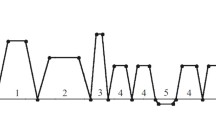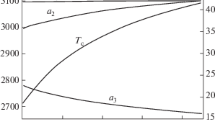Conclusions
-
1.
Use of a special furnace design with a built-in centrifugal fan that provides for circulation of the gaseous mixture at a rate of approximately 2 m/sec at a low gas-consumption rate makes it possible to conduct carburizing in a N2−H2−CH4 mixture without the formation of soot on the surface of the components.
-
2.
In saturating a commercial-iron foil up to 45 μm thick with carbon in a gaseous N2−H2−CH4 mixture to a content that exceeds its solubility in austenite, a thin layer of cementite forms at the surface of the foil. A further extension of the carburizing time has virtually no effect on the thickness of the cementite layer and gives rise to the formation of a pyrocarbon film on the surface of the foil.
-
3.
A carburized layer of appreciable thickness (about 1.0 mm after isothermal holding for 4 h at 930°C) and with a smoother concentration profile than that obtained with two-stage carburizing in other gaseous media forms during the carburizing of steel 18Kh2N4MA specimens in an N2−H2−CH4 medium.
-
4.
Control of the carburizing process is facilitated with the use of an N2−H2−CH4 mixture. For a constant Cg value, control is, by nature, reduced to maintenance of the methane concentration in the mixture and to selection of the carburizing time.
Similar content being viewed by others
Literature cited
R. Smith, "Equilibrium of iron-carbon alloys with mixtures of CO−CO2 and CH4−H2," J. Am. Chem. Soc.68, No. 7, 1163–1175 (1946).
B. M. Éstrin, "Carburizing in a gaseous Ch4−H2−H2O mixture diluted with nitrogen," Metalloved. Term. Obrab. Met., No. 10, 31–35 (1979).
G. A. Yudin et al., "Use of solid-electrolyte cells to measure the moisture content of protective atmospheres," Stal' No. 8, 642–644 (1979).
A. G. Bozhkov, S. L. Rustem, and T. A. Fedorova, "A nitrogen-based atmosphere for case hardening," Metalloved. Term. Obrab. Met., No. 9, 26–27 (1980).
B. S. Bokshtein, Diffusion in Metals [in Russian], Metallurgiya, Moscow (1978).
G. D. Kuznetsov, "Effect of ion bombardment on structural and phase transformations during case hardening in a glow discharge," Metalloved. Term. Obrab. Met., No. 11, 21–27 (1981).
Additional information
Trust for Electrical Assembling Operations in Central Asia. "Zvezda" Production Association. Translated from Metallovedenie i Termicheskaya Obrabotka Metallov, No. 5, pp. 26–29, May, 1984.
Rights and permissions
About this article
Cite this article
Éstrin, B.M., Mnushkin, O.S., Shkol'nikov, M.A. et al. Carburizing in a nitrogen-based mixture with additives of pure methane. Met Sci Heat Treat 26, 349–353 (1984). https://doi.org/10.1007/BF00707407
Issue Date:
DOI: https://doi.org/10.1007/BF00707407




